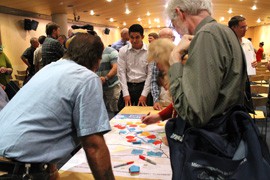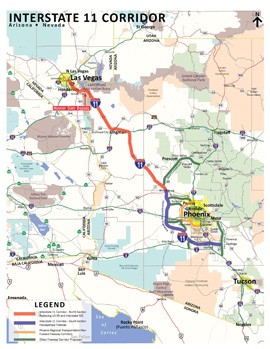Cronkite News has moved to a new home at cronkitenews.azpbs.org. Use this site to search archives from 2011 to May 2015. You can search the new site for current stories.
With two-year ADOT study, interstate linking Valley with Las Vegas moves closer to reality
PHOENIX – Dianne Barker doesn’t drive to Las Vegas often from her home in Phoenix, but she likes the idea of a proposed interstate linking the cities.
“I think this would be a tremendous opportunity for the economy,” she said. “Not only in the efficient transfer of goods with the freight, but even in the short term there would be tremendous job opportunities.”
Sandy Bahr, director of the Sierra Club’s Grand Canyon Chapter, worries that the interstate would increase air pollution, primarily from trucks.
“We need to start thinking about how we develop things relative to the impacts on climate change,” she said.
The 160 people who recently attended the Arizona Department of Transportation’s first public meeting on the proposed Interstate 11 offered conflicting opinions. But opinions are exactly what ADOT and its counterpart in Nevada are looking for as they begin a two-year study required before moving forward.
“We’re just at the beginning and no decisions have been made yet, and that’s why we’re out to talk to the public to get their input so early in this study,” said Michael Kies, project manager for ADOT.
The $2.5 million study is part of a $105 billion transportation bill signed into law in July that made I-11 eligible for federal funding.
Phoenix and Las Vegas are the largest cities in the country not linked directly by an interstate.
As it stands, I-11 would begin near Coolidge and bypass the Phoenix area to the south until heading north along the the Hassayampa River west of the Valley. It would connect at Wickenburg with the alignment of U.S. 93, which runs to Las Vegas via Kingman and over the new bypass at Hoover Dam.
Now the transportation departments in Arizona and Nevada are working with the Maricopa Association of Governments and other stakeholders to evaluate corridor routes, multimodal transportation possibilities, timelines and economic and environmental impacts.
“There are a lot of questions out there, and that’s what the engineers who are going to be helping us with the study are going to help us figure out,” said Robert Hazlett, senior engineering manager for MAG, a regional planning agency for the Phoenix metropolitan area.
The concept for an interstate between Phoenix and Las Vegas originated in 2005, when MAG identified a need to accommodate Arizona’s rapidly growing population. With nearly 4 million people in the Valley, MAG projects that the area could grow to 6 million by 2050.
“When you have to start planning, you want to make certain not only that there’s housing for them but there’s jobs for them and that there’s also transportation between all those for folks being able to get back and forth,” Hazlett said. “I think that I-11 in and of itself is an answer to the growing populations we’ve had both in Phoenix and Las Vegas.”
Eventually, the I-11 corridor could expand to Mexico and Canada. However, ADOT spokeswoman Laura Douglas said nothing’s a done deal, and that’s what the study will address.
“We really can’t say that is the definite line on the map,” she said. “It’s an area we’re looking at, but depending on environmental work and further engineering studies, it could take a different route.”
Gov. Jan Brewer has touted I-11 as a key to growing Arizona’s economy in terms of jobs and tourism. Brewer’s spokesman, Matthew Benson, said the interstate would improve commerce.
“Arizona is competing with these other border states to be the hub where companies and any entity that’s shipping products choose to bring those products across the border,” he said. “We want to be the hub for those products, and I-11 would help us significantly.”
John Mathis, global finance professor at the Thunderbird School of Global Management, said I-11 is a major component of the 1994 North American Free Trade Agreement, which was intended to increase international trade between Canada, Mexico and the U.S. and make a wider variety of products available and less expensive.
“It’s the execution of the NAFTA policy to open trade,” he said. “So if you open trade and you don’t build the port to facilitate trade, then the policy means nothing.”
Although the interstate might help the economy, Bahr of the Sierra Club said it could also kill towns, pointing to areas along historic Route 66 that withered when Interstate 40 came along.
“Anybody that is thinking they’re going to support this because it’s great for their town should ask a few more questions and really look at it to see whether it is indeed going to be something beneficial for their community,” she said.
If Interstate 11 does follow U.S. 93, Mohave County Supervisor Buster Johnson said it would help attract businesses to Kingman.
“It’s cheaper to build and run a business in the Kingman area than the Phoenix area or in the Vegas area,” he said. “So if they could locate here, they save costs and they can still be in Vegas, Phoenix, Tucson, Salt Lake City and California in a short amount of time.”
While Robert Hazlett said no one knows whether the highway would be completed in 10 or 20 years or if it would be supported by federal funds or tolls, all those questions will be answered in the study.
“It’s not going to be cheap by any means, but at the same time, how do we know what the amount is unless we do the studies to figure out what that exact amount is going to be so that the policy makers can make the decision?” he said.








